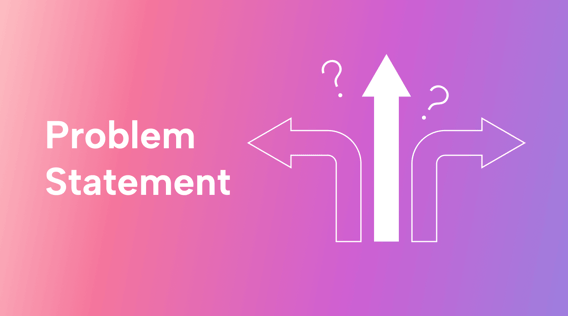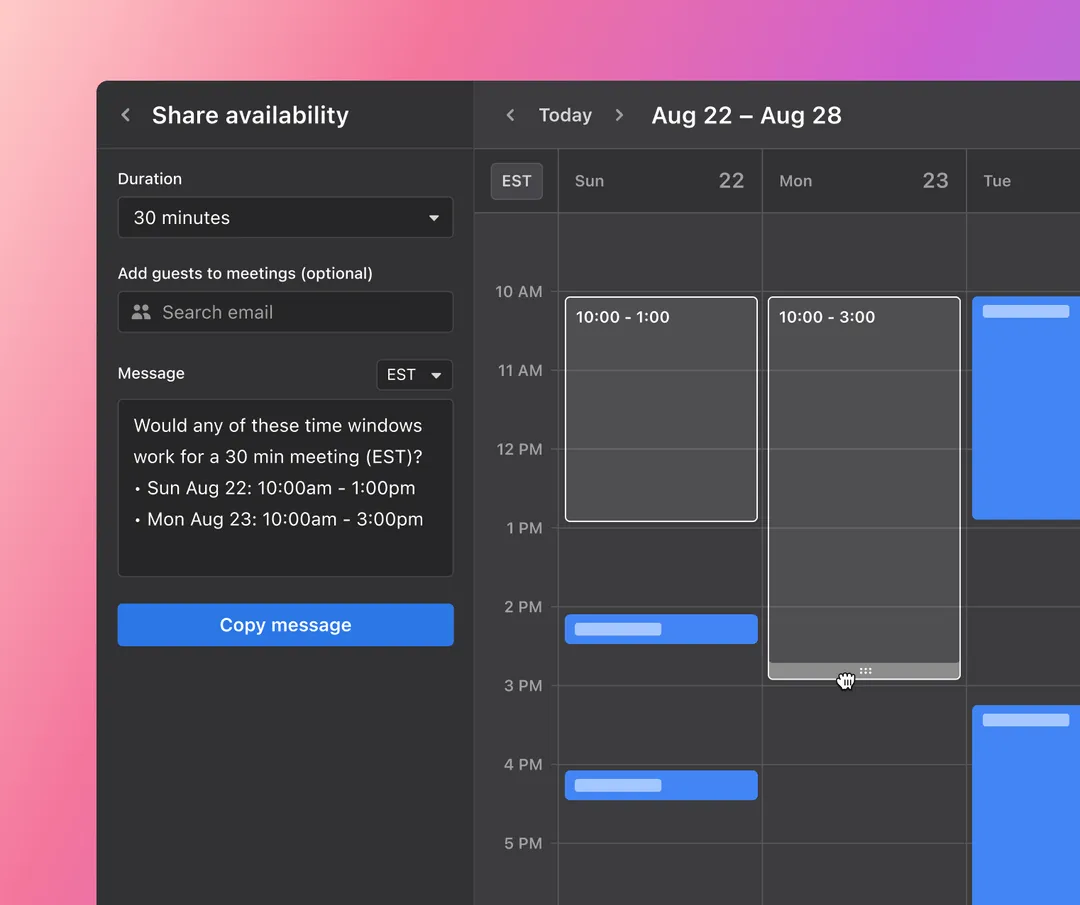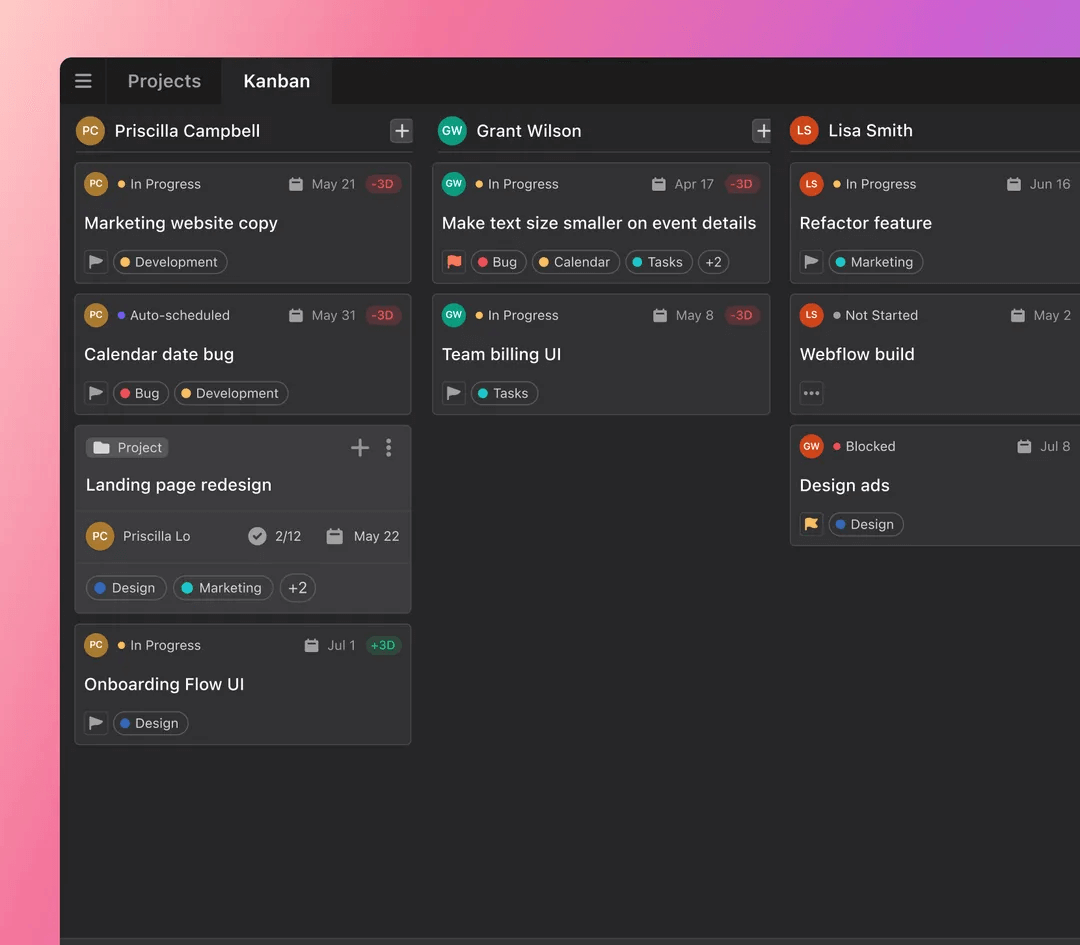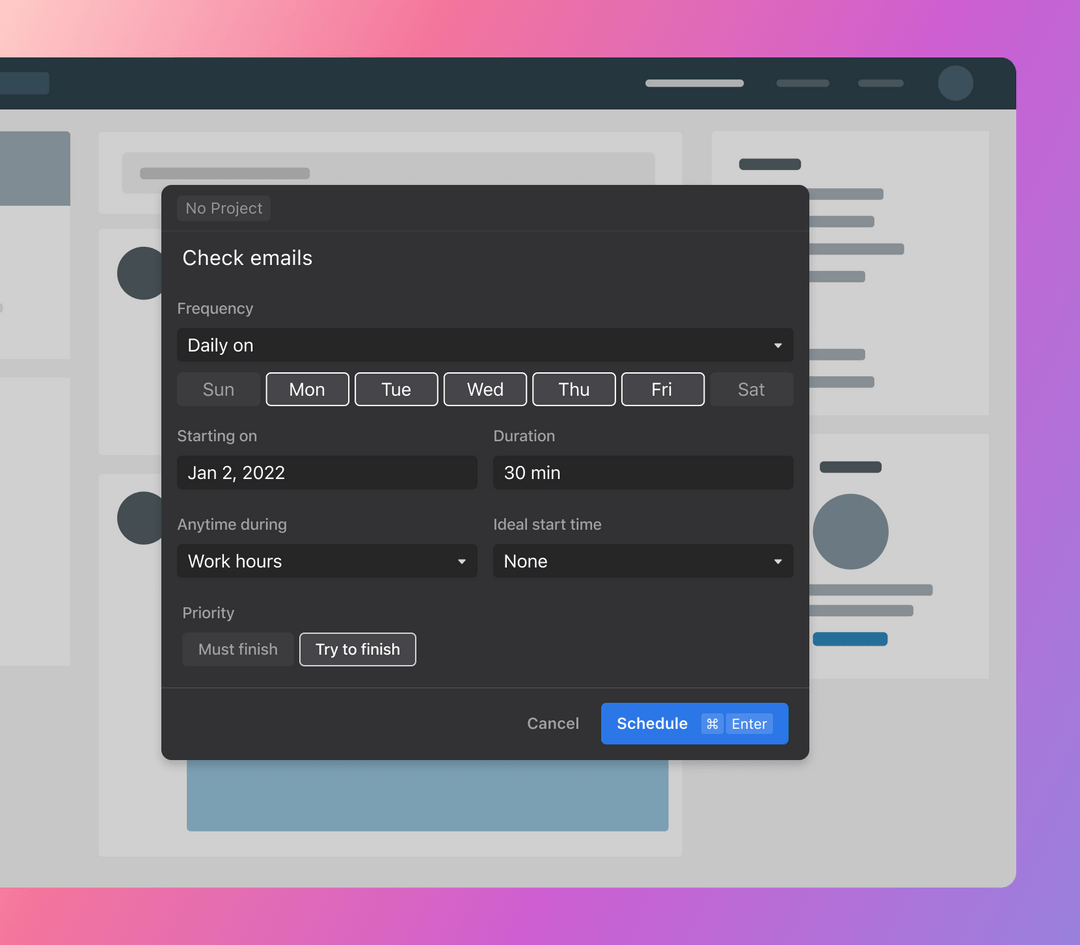When a problem arises at work, do you analyze the situation first or jump into possible solutions?
Tackling issues head-on is instinctive, especially if you’re a manager or team leader. But without a clear understanding of why they’re happening, you can find yourself chasing the wrong solutions.
A problem statement clarifies the root causes of challenges and sets you on a path toward their resolution. In this guide, we walk you through writing a concise problem statement and discuss solutions for common problem statement challenges.
What is a problem statement?
Whenever an issue arises in a job, it’s helpful to figure out its root cause.
A problem statement breaks this down for us. It’s a clear summary of the challenge at hand, which helps us understand the situation and find the right solution.
When do you need to write one?
The long-term success of any business relies on understanding and addressing its core issues.
Four in ten CEOs know their company needs significant transformation to last the next decade. And these businesses need to change on a deep level, not just fix whatever is currently broken. That means they need to have total clarity over the challenges they’re facing.
Differentiating between the issue and its symptoms helps ensure that all efforts are channeled toward impactful, lasting solutions. Writing a problem statement is a necessary step in understanding the issues businesses face.
What should a problem statement include?
A problem statement typically consists of three key elements:
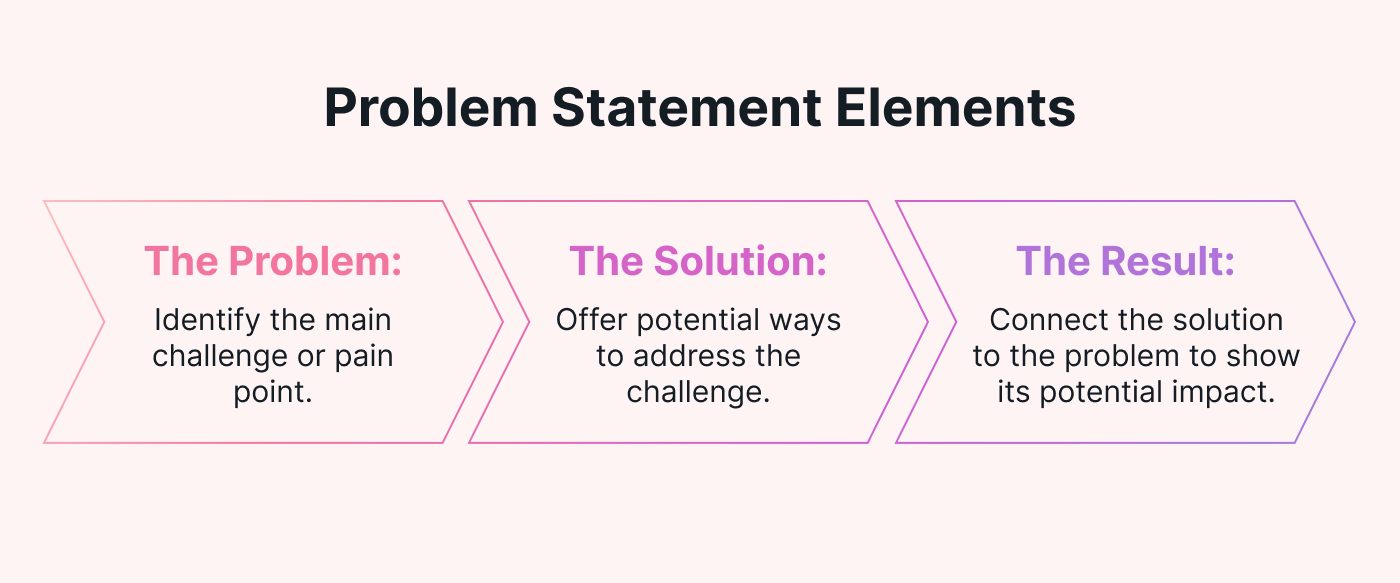 |
The problem
This section identifies the main challenge or pain point. Without clear identification, efforts can be easily misdirected.
The problem should be specific and concise, focusing on the core issue without getting lost in the details.
The proposed solution
The proposed solution offers potential ways to address the challenge. It provides direction, showing how strategies align with the problem.
This section should include actionable steps or methods — ideally backed by data, research, or expert advice.
The result
The last section connects the solution to the problem to show its potential impact.
Demonstrating possible outcomes will help stakeholders understand the value and implications of addressing the problem. The result should outline the positive changes expected once the solution is implemented.
How to write a problem statement in 5 steps
Writing an effective problem statement takes a certain degree of know-how and diligence. But, as you start using this technique to resolve workplace issues, you’ll get better at creating a problem statement that drives powerful solutions.
If you’re new to problem statements, follow these steps to ensure clarity and purpose throughout the resolution process.
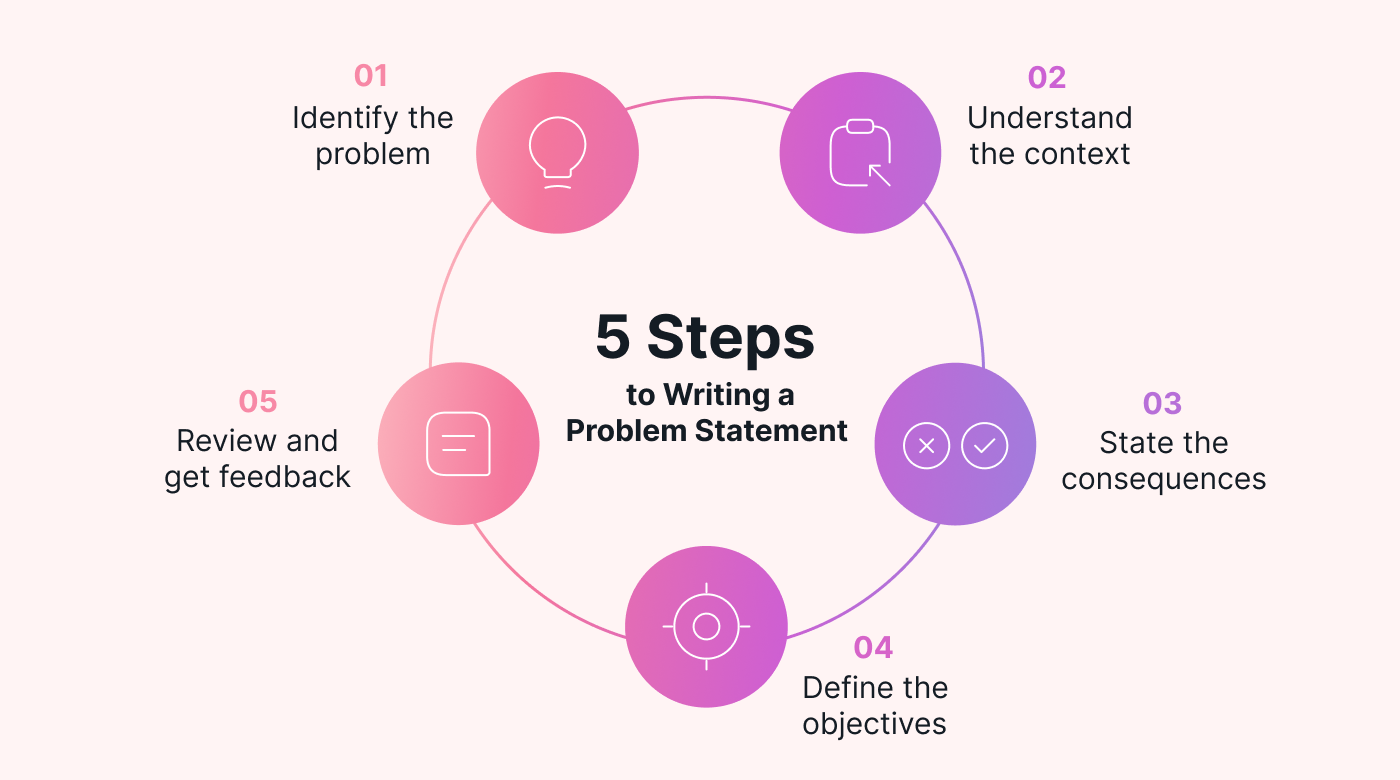 |
1. Identify the problem
Before digging into potential solutions, it’s important to recognize and define the core issue. Start by gathering preliminary data or seeking feedback relevant to the issue.
This could mean conducting surveys, holding focus group discussions, or even analyzing past records and reports to identify patterns. For example, if you suspect a decline in product sales, you can review sales data over the past six months and hold meetings with the sales team to gather insights.
This step ensures that the identified problem is based on tangible evidence — not just a hunch or personal bias. Remember, correctly identifying the problem sets the trajectory for the next steps. A misdiagnosis at the initial stage can lead to wasted efforts down the road.
2. Give context
Once the primary problem is identified, it’s equally important to understand its background and how it fits into the larger picture. Offering background information, such as the history or external causes of the issue, helps stakeholders understand the broader scenario.
Ask yourself: Have there been previous attempts to tackle this problem? If so, what were they, and why didn’t they work? These details will provide a comprehensive view, which can be the key to crafting a solution that’s different from past efforts.
Understanding the reasons behind the problem’s existence not only paints a clearer picture for those involved but also helps ensure that any proposed solution addresses the root cause, not just its manifestations.
3. State the consequences
Next, communicate what’s at stake. What are the potential consequences if this problem goes unresolved? Discussing the possible negative outcomes emphasizes the urgency and significance of the issue at hand.
Moreover, understanding the problem’s ripple effects means looking beyond the immediate aftermath. How might the problem impact stakeholders, from team members to investors or clients? An unaddressed issue might increase a business’s financial costs, tarnish its reputation, or lead to a high employee turnover rate.
Making the consequences clear conveys the full weight of the situation to everyone and can be a powerful motivator for action.
4. Define the objectives
Now it’s time to clarify what success looks like. Consider what the end result should look like, and write it down. Setting a clear vision for the desired outcome gives you a tangible target to aim for.
But a vision isn’t enough on its own. Establish clear metrics or benchmarks to make sure that you’re making real, measurable progress.
This could mean hitting a specific sales target, achieving a particular customer satisfaction score, or reaching any other quantifiable goal. These benchmarks will not only keep you on course but also give you moments to recognize and celebrate the progress you’ve made toward resolving the issue.
5. Review and get feedback
Once you’ve drafted your problem statement, ask for feedback. Engaging with stakeholders or team members can offer fresh insights and diverse perspectives that shed light on overlooked areas or other viable solutions.
Think of this process as collaborative fine-tuning. Every piece of feedback, whether it supports or challenges your initial thoughts, is an opportunity for refinement. Take the time to review and tweak your problem statement as you receive new input. Incorporating different viewpoints will help you develop a more well-rounded and comprehensive approach to problem-solving.
3 problem statement examples in the workplace
Through concrete examples, you can better understand the application and impact of a problem statement in a professional setting. Let’s take a look at three common workplace scenarios where clear problem statements provide clarity and direction to guide effective solutions:
1. Team communication
Problem: Team members in the marketing department use multiple communication channels for project updates, leading to missed messages and confusion on the project’s status.
 |
Problem statement: “Due to the fragmented use of multiple communication tools in the marketing department, critical project updates are often missed or overlooked. The result is project delays and potential derailment. An efficient, centralized communication system would ensure all team members stay aligned and informed.”
2. Employee onboarding
Problem: New employees are feeling lost and overwhelmed during their first week because there isn’t a clear or structured onboarding plan. They face steeper learning curves, significantly reducing their initial productivity.
Problem statement: “Without a streamlined onboarding process, our new employees feel unsupported and struggle to find their way in the first week. This makes it take longer for them to adjust to their role and start working at their best. We need a straightforward and accessible onboarding process and knowledge bank to help them settle in faster and perform from the start.”
3. Workspace utilization
Problem: Almost every day, employees are confronted with double-booked meeting rooms even though there are several open spaces available. This inconsistency not only causes inefficiencies but also stirs up tension between departments.
Problem statement: “Our current system for allocating office spaces is leading to double-booked meeting rooms and underused open areas. Employees waste time looking for appropriate spaces, hindering their productivity and satisfaction. Implementing a more transparent and easy-to-use booking system will optimize workspace use and reduce these disruptions.”
4 challenges of writing a problem statement
Although writing a problem statement is pretty straightforward, there are a couple of challenges you need to watch out for. Recognizing these pitfalls will help you avoid drafting a statement that doesn’t produce the outcomes you expect.
In this section, we not only discuss these challenges but also provide tips on how to overcome them.
1. Over-complicating or being too vague
At first, it can be tough to strike the right balance between simplicity and depth in a problem statement. On the one hand, you want to offer enough detail for the problem to be clear and actionable. On the other hand, overloading it with intricate details can muddle its purpose and confuse readers.
An overly simplistic statement also risks being too ambiguous, leaving teams uncertain about the real challenge or how to tackle it. Always aim for clarity and precision, making the statement both concise and informative.
Tip: A good place to start is with the “Five Whys.” Start by asking why the problem exists, and then ask “why” again to the proposed solution. Repeat this process five times, each time digging deeper to uncover the root cause. This technique will help you distill the core issue and remove superficial symptoms.
2. Ignoring stakeholders’ perspectives
Writing a problem statement without considering multiple viewpoints can lead to a one-sided understanding of the issue. Unfortunately, only one in two employees actively seeks and provides feedback.
Not seeing other viewpoints means you might be missing important details that will help resolve the problem. Ask your team to contribute and give feedback so you get a holistic view of the issue.
Tip: Make sharing ideas and collaborating easier for your team. With a tool like Motion, team collaboration happens automatically and in real time. Your team members can easily share their availability, schedule brainstorming sessions, and communicate via direct channels. No messages get lost, and everyone’s voice is heard.
3. Misalignment with organizational goals
Eye-opening four-year research discovered that while 82% of managers and employees believe they are in tune with their company’s corporate strategy, a written analysis revealed a stark reality: only 23% are truly aligned.
This mismatch often results in problem statements that might work short-term but don’t align with the company’s overall goals. As a result, misdirected solutions might fix surface-level issues but fail to address the deeper root causes that are integral to long-term success.
Tip: To foster alignment between your employees and your company, consider using group calendars — tools that visually document your ongoing projects and goals. Motion’s group calendar keeps everyone on the same page, making it easier to track project progress and solution implementation.
4. Failing to review and revise
Creating a problem statement isn’t a one-and-done task. Just as businesses and circumstances evolve, so should your problem statements. A static problem statement can quickly become outdated, losing its relevance as situations change or new information emerges.
Revisit and refine your problem statement periodically to maintain its effectiveness and accuracy. This will help ensure it reflects your business’s current needs and challenges.
Tip: Reviews can be easily pushed to the back burner when work gets busy. So, schedule regular reviews to prioritize them. Motion automates recurring tasks, saving you the extra step of setting manual reminders and scheduling.
Bullet-proof your problem statement with Motion
A well-defined problem statement requires clarity, inclusivity, alignment, and flexibility as circumstances change.
Unforeseen challenges can muddy the waters when you’re trying to write a clear and actionable problem statement. Fortunately, this is where Motion comes into play.
Motion simplifies team collaboration with group calendars and direct communication channels so that everyone stays on the same page and can easily share their input. Our automated tasks and scheduling tools also act as friendly reminders, nudging you to revisit and refine your problem statements as needed.
Keep each problem statement adaptive and current to match your company’s evolving needs. Want to experience the difference Motion can make in your business? Try our free 7-day trial today.

